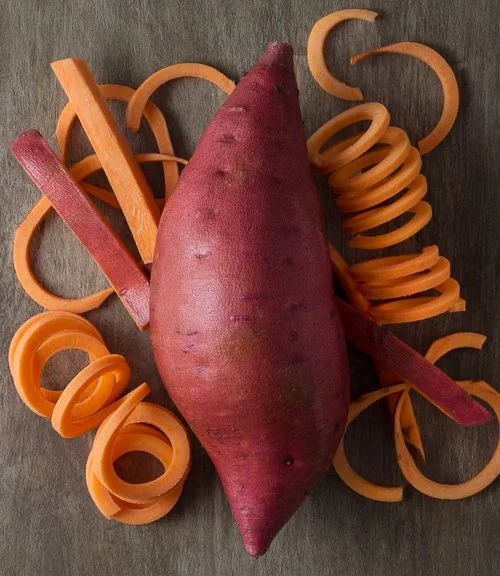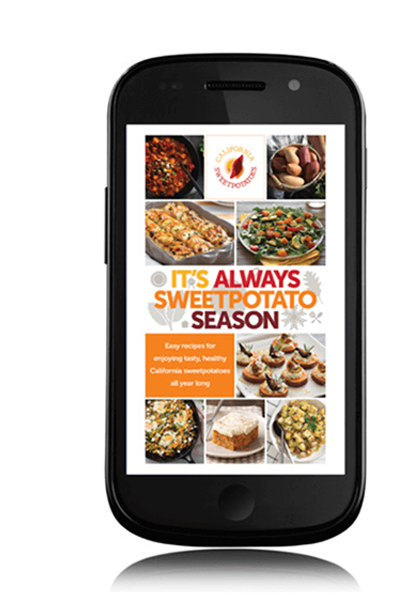types of sweetpotatoes
There are dozens of different sweetpotatoes, ranging from white and mild to deep red and super sweet. There are even purple sweetpotatoes! Many of the more unusual varieties are grown in small quantities—and sometimes you can find them at farmers markets—but only about twelve varieties are grown commercially.
More important than looking for a specific variety, however, is to shop by color. These are the most popular grown in California, along with the variety names you might see associated with them:
WHICH TYPE SHOULD I USE?
All four types have similar cooking times and so can be used pretty much interchangeably in recipes. If a recipe calls for one type or the other, it’s probably best with that type, but if it doesn’t, the choice is yours.
So how do you choose? A couple of tips.
Orange-fleshed sweetpotatoes will add a little more sweetness to whatever you’re cooking. Since they’re a little more moist, they’re also slightly wetter when mashed. And for the same reason, if you’re looking for browning or crispness, they might need a little more space in the skillet or on the baking sheet.
Yellow/white-fleshed sweetpotatoes, because they’re a little less sweet and they cook up a little more dry, are a good choice when you’re looking for browning or crispness, like in sweetpotato fries or shredded sweetpotato hash. Because of those qualities, they also make a good substitute for regular potatoes.
All that said, the differences aren’t huge. It’s a rare recipe that isn’t great using either orange-fleshed or yellow/white-fleshed sweetpotatoes—or a combination of the two!
Click here for more basic sweetpotato cooking info.
HOW TO PICK A PERFECT SWEETPOTATO
First, look for sweetpotatoes from California! Then choose ones that are firm and dry, with no signs of decay. If you’ll be cooking them whole, pick sweetpotatoes that are uniformly sized and shaped so they’ll cook evenly.
HOW TO STORE SWEETPOTATOES
Once you get them home, store your sweetpotatoes a cool, dry place, ideally with some ventilation. About 55°F is perfect. Don’t store them in the refrigerator—it can produce a hard core at the center and unpleasant flavors. It’s always better to store them warmer than colder.
Don’t wash your sweetpotatoes until you plan to use them. And for the best texture and flavor, use them within a week or two.
(How come we can harvest sweetpotatoes in the fall and store them the rest of the year, making them available for year-round enjoyment, but you should store them for only a week or two? Because we have special storage units that are constantly monitored to keep things absolutely ideal.)
WHAT’S THE DIFFERENCE BETWEEN SWEETPOTATOES AND YAMS?
Sweetpotatoes are sometimes referred to as yams, especially orange-fleshed sweetpotatoes. But technically, none are yams—they’re all sweetpotatoes.
There is such a thing as a yam, but it’s botanically unrelated to a sweetpotato. True yams are a starchy, dry root vegetable with a tough, bumpy, dark brown skin. They’re pretty impossible to find in most parts of the U.S., so if you see something at your supermarket labeled “yam,” chances are your grocer is simply using the colloquial term and it’s actually a sweetpotato.
Why all the confusion? Back in the 1930s, Louisiana sweetpotato growers wanted to distinguish their orange-fleshed varieties from the yellow-fleshed types in other states. So they chose a variation of the African word nyami—“yam.” Today, to combat that confusion, the USDA requires that all sweetpotatoes be labeled as such.
“SWEETPOTATO” IS ONLY ONE WORD? REALLY?
On this one we admit there’s not a lot of agreement. But we believe that “sweetpotato” is correct because our product is not, in fact, a sweet potato. It’s not a potato at all, but botanically an entirely different vegetable, gifted with a totally different set of better-for-you nutrients, amazing taste, and incredible versatility. So sweetpotatoes—one word—is not only grammatically correct, but it helps make the distinction.








Orange
An orange skinned, orange-fleshed sweetpotato. Varieties include Jewell, Covington, Bellevue, and Beauregard. When cooked, the meat is super-sweet and very moist, especially as compared to pale yellow- or white-fleshed types.